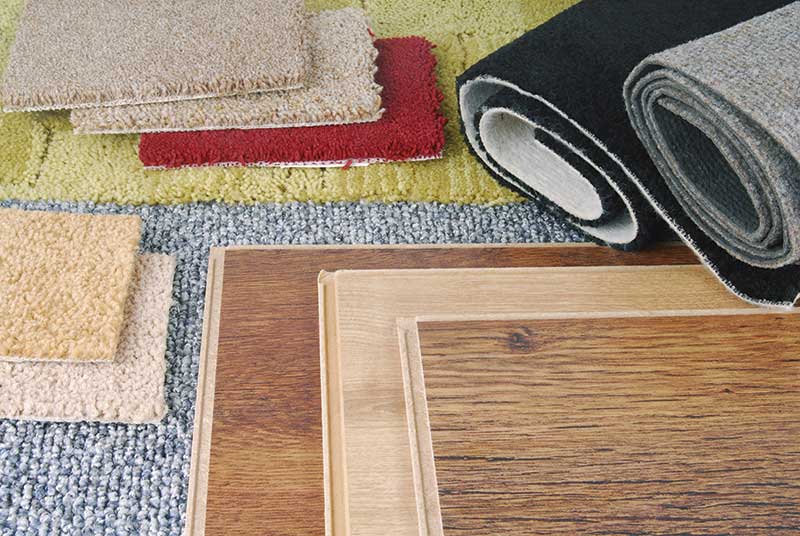 The main difference between different flooring materials and their suitability for use with the system is the material’s thermal conductivity, meaning how quickly and efficiently heat generated transfers to the floor surface. The best flooring for underfloor heating is flooring with good conductivity as it heats up quicker, gives more heat output and is more efficient to run. However, this does not mean that less conductive materials could not be used with underfloor heating.
The main difference between different flooring materials and their suitability for use with the system is the material’s thermal conductivity, meaning how quickly and efficiently heat generated transfers to the floor surface. The best flooring for underfloor heating is flooring with good conductivity as it heats up quicker, gives more heat output and is more efficient to run. However, this does not mean that less conductive materials could not be used with underfloor heating.
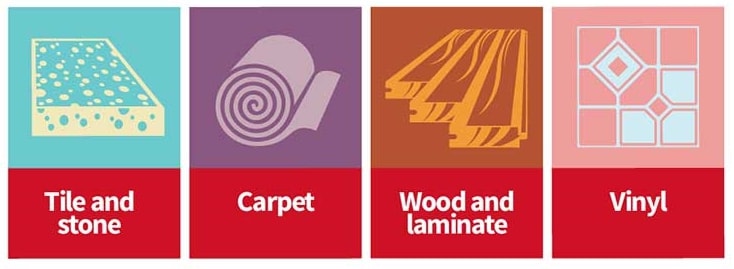
The best type of flooring to use with underfloor heating is tile and stone. However, a compatible radiant heating system can be found for almost every floor finish. Suitable floorings include:
- Tile, Stone & Polished Screed Flooring
- Wood & Engineered Timber Flooring
- Laminate Flooring
- Vinyl Flooring
- Carpet & Rug Flooring
- Rubber Flooring
Whether you’re renovating or choosing flooring for a new build, we outline in this article what you need to know about different flooring for underfloor heating.
TYPES OF FLOORING
Underfloor heating can be used under any floor. The only difference between which floor finish to use with an underfloor system is the thermal conductivity of the material.
TILE, STONE & POLISHED SCREED
The best type of flooring to use with underfloor heating is tile and stone. Tile and stone have high thermal conductivity, meaning that the heat from an underfloor heating pipe or wire transfers to the floor surface quickly. Tile and stone also retain heat well making the system efficient. Due to the excellent thermal properties, tile and stone are ideal for use with underfloor heating in high heat loss areas such as conservatories. They can be heated to up to 29°C or more, giving a high heat output of up to 200W/m².
The thickness of the tile and stone has little impact on the heat output, but it does increase the heat up time a little so sticking to a maximum thickness of 20mm is recommended when you’re seeking a highly responsive system.
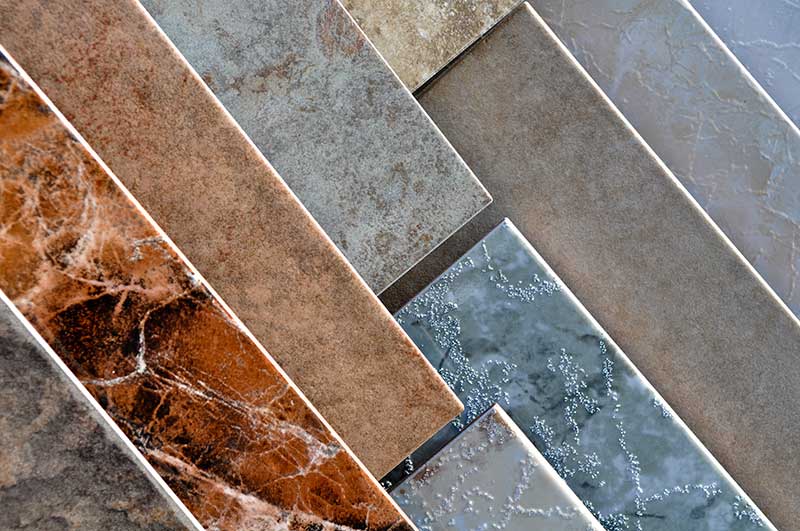
Tile and stone floors are highly conductive making them the best flooring to use with underfloor heating.
Ceramic & stone tiles
- The best floor material to use with underfloor heating
- Excellent heat transfer properties & thin profile
- Easy to keep clean
Polished concrete
- Highly conductive allowing fast heat up time
- Suitable for use with electric and water based underfloor heating
Slate and flagstone
- Naturally highly conductive and great with underfloor heating
- Hard-wearing floor finish ideal for high footfall areas
Marble
- Good thermal conductivity, but slower heat up
Installation tips: underfloor heating with tile & stone
- You must use a quality 2 part flexible tile adhesive when installing underfloor heating with tiles.
- When installing on a concrete subfloor, always use insulation.
WOOD FLOORING
Different types of wood flooring have different thermal properties, as such, there are differences in their suitability for use with an underfloor heating system. The denser and the thinner the floorboards are, the better they conduct heat and typically more suitable they are for use with underfloor heating.
Engineered timber is the best type of wood flooring to use with an underfloor heating system as it performs well with changes in floor temperature. Other wood flooring may also be used, but with softer and less dense wood attention must be paid to the thickness of floorboards so that the floorboards do not act as an insulator blocking the heat. As a general rule for wood flooring, the floor surface temperature must not exceed 27°C.
Heating the floor changes the moisture content of wood, so you should choose wood flooring that can adapt to the changes in floor temperatures without changing the appearance of the floor. Kiln-dried wood tends to work best with floor heating, but always check with the flooring manufacturer about suitability for use with underfloor heating.

Underfloor heating can be used with different wood flooring types, but attention must be paid to the thickness of the floorboards so that they do not act as an insulator blocking the heat.
Engineered timber
The best wood flooring to use with underfloor heating. It performs well with the changing floor temperature and adapts to the changing moisture content
Solid hardwood
Prone to humidity and temperature changes which could result in gapping, cupping and crowning. Care must be taken when considering use with underfloor heating to ensure compatibility and high enough heat output – always check with the manufacturer about suitability for use with underfloor heating
Soft woods
Suitable for use with underfloor heating, but attention must be paid to the thickness of floorboards to ensure high enough heat output
Parquet floor
Available in either solid wood or engineered timber and most types are suitable for use with underfloor heating
Bamboo
Similar to engineered wood in construction and as it is a good conductor of heat, it is well suited for use with underfloor heating
Installation tips: underfloor heating with wood flooring
Wood is a natural material which is affected by the humidity of the environment around the material. This is why it’s important to ensure the correct moisture content of wood flooring during installation and the correct heating cycle when installing underfloor heating
Engineered timber can be laid directly over underfloor heating with floating floor or batten/ jointed system. Boards less than 20mm thick should be supported and fixed to provide suitable structural support. Low tog underlays are recommended when installing the boards over screed.
LAMINATE FLOORING
This synthetic floor simulates wood and offers a stain and scratch resistant floor finish. It’s easy to lay and a cost-effective solution. Most laminates are suitable for use with underfloor heating, but it is advisable to check with the flooring manufacturer before installing the system.
VINYL FLOORING
Vinyl flooring can be safely used with underfloor heating. Vinyl heats up and cools down quickly. Vinyl floors are subject to a top floor temperature restriction, usually 27°C, limiting the heat output so they are not recommended in high heat loss areas such as older conservatories.
RUBBER FLOORING
Rubber can be used with underfloor heating. Solid rubber flooring is usually very conductive making it heat up fast and provide high heat output. Always consult the manufacturer to ensure suitability for use with underfloor heating.
CARPET FLOORING
Carpet is suitable for use with underfloor heating, provided that the material of the carpet or underlay does not act as an insulator blocking the heat. The total tog of all materials, including any under and overlays, must not exceed 2.5 tog in order for the system to provide sufficient heat output.

Laminate and carpet flooring is suited for use with underfloor heating, but you must ensure that the total tog of all materials does not exceed 2.5 tog for the system to provide enough heat output.
HEAT UP TIMES OF DIFFERENT FLOORS
The choice of flooring material affects the heat up time, as each material has different thermal mass and conductivity. The lower thermal mass and higher the conductivity, the quicker the heat from an underfloor heating pipe or wire transfers onto the floor surface. However, this also means that materials with low thermal mass cool down faster than materials with high thermal mass. The responsiveness of a system can be improved by using insulation boards to promote the transfer of the heat to the floor finish.
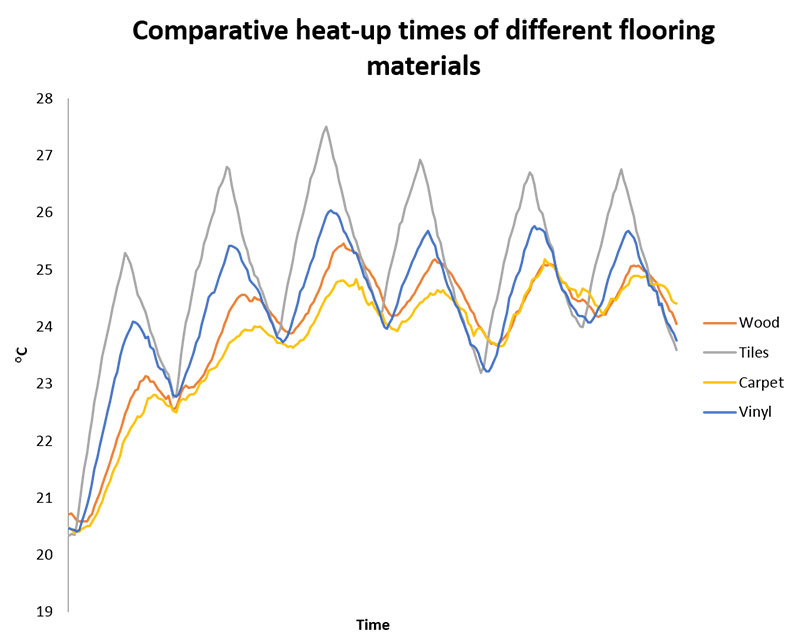
FLOORING MATERIAL’S IMPACT ON HEAT OUTPUT
The choice of flooring affects the maximum heat output of the system as certain floor finishes have a top temperature restriction, limiting the maximum heat output. The heat output of a system is dependent on the overall heated floor area and air and floor temperatures. Heat output is influenced by changing any of these three factors. It’s usually the easiest to change the floor finish as the room size and comfort air temperature are already pretty much set.
It’s important to ensure that the heat output from the floor is greater than the heat loss figure of the room. As the graph below illustrates, a two-degree difference in the floor temperature makes a great difference in heat output. So, if your chosen flooring can only be heated to 27°C, and this does not give you the heat output you need, you may benefit from changing to a floor finish that can be heated to 29°C to give more heat output. Additionally, you can consider adding supplementary heating to ensure your heating system meets your expectations.
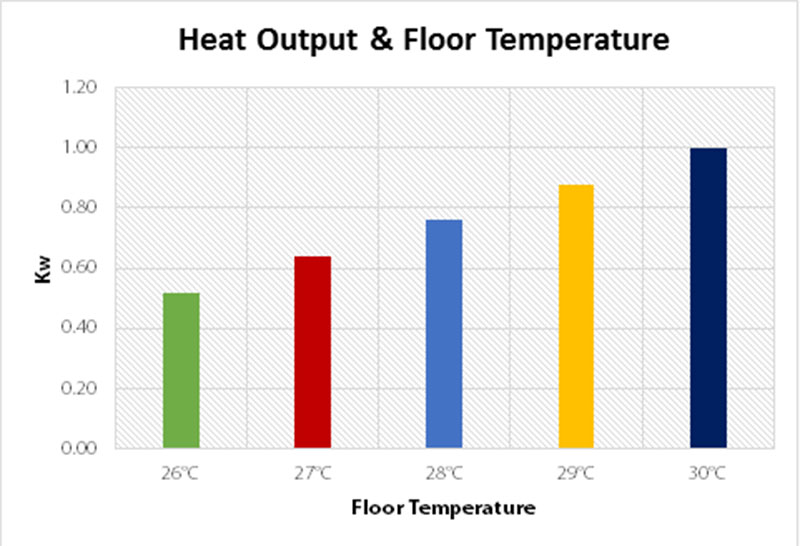
The maximum heat output is directly linked to the floor temperature. The graph illustrates the maximum heat output of an underfloor heating system when the desired room temperature is 21°C and the heated area 10m².
If you’re looking to get underfloor heating, take a look at our underfloor heating product range to find a system suitable for use with your chosen floor finish or request a free quote here.





